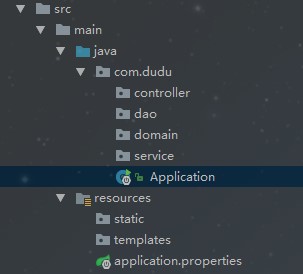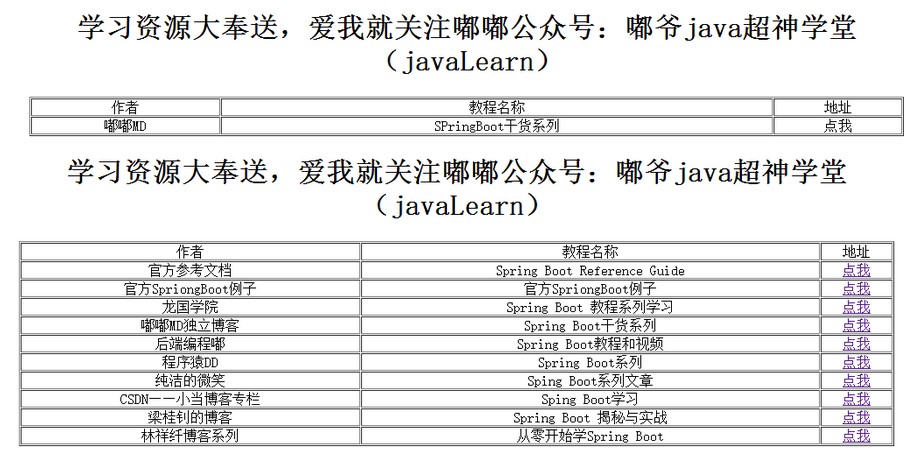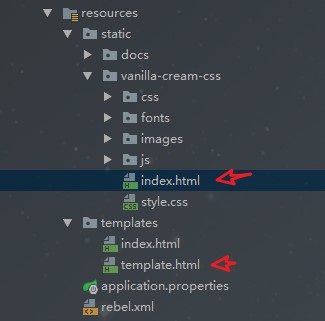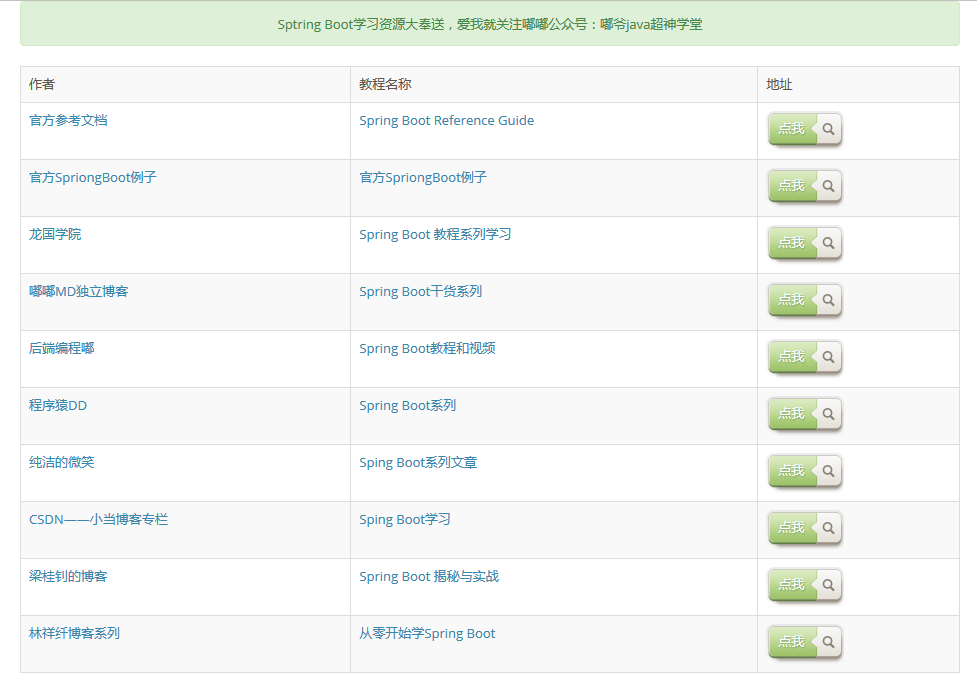
前言
Web开发是我们平时开发中至关重要的,这里就来介绍一下Spring Boot对Web开发的支持。
正文
Spring Boot提供了spring-boot-starter-web为Web开发予以支持,spring-boot-starter-web为我们提供了嵌入的Tomcat以及Spring MVC的依赖。
项目结构推荐
一个好的项目结构会让你开发少一些问题,特别是Spring Boot中启动类要放在root package下面,我的web工程项目结构如下:
- root package结构:
com.dudu - 应用启动类
Application.java置于root package下,这样使用@ComponentScan注解的时候默认就扫描当前所在类的package - 实体(Entity)置于
com.dudu.domain包下 - 逻辑层(Service)置于
com.dudu.service包下 - controller层(web)置于
com.dudu.controller层包下 - static可以用来存放静态资源
- templates用来存放默认的模板配置路径
Spring Web MVC框架介绍
Spring Web MVC框架(通常简称为”Spring MVC”)是一个富”模型,视图,控制器”的web框架。
Spring MVC允许你创建特定的@Controller或@RestController beans来处理传入的HTTP请求。
示例:1
2
3
4
5
6
7
8
9
10
11
12
13
14
15
16
(value="/users")
public class MyRestController {
(value="/{user}", method=RequestMethod.GET)
public User getUser(@PathVariable Long user) {
// ...
}
(value="/{user}/customers", method=RequestMethod.GET)
List<Customer> getUserCustomers(@PathVariable Long user) {
// ...
}
(value="/{user}", method=RequestMethod.DELETE)
public User deleteUser(@PathVariable Long user) {
// ...
}
}
Spring MVC自动配置
Spring Boot为Spring MVC提供适用于多数应用的自动配置功能。在Spring默认基础上,自动配置添加了以下特性:
- 引入ContentNegotiatingViewResolver和BeanNameViewResolver beans。
- 对静态资源的支持,包括对WebJars的支持。
- 自动注册Converter,GenericConverter,Formatter beans。
- 对HttpMessageConverters的支持。
- 自动注册MessageCodeResolver。
- 对静态index.html的支持。
- 对自定义Favicon的支持。
如果想全面控制Spring MVC,你可以添加自己的@Configuration,并使用@EnableWebMvc对其注解。如果想保留Spring Boot MVC的特性,并只是添加其他的MVC配置(拦截器,formatters,视图控制器等),你可以添加自己的WebMvcConfigurerAdapter类型的@Bean(不使用@EnableWebMvc注解),具体拦截器等配置后续文章会解析。
静态文件
默认情况下,Spring Boot从classpath下一个叫/static(/public,/resources或/META-INF/resources)的文件夹或从ServletContext根目录提供静态内容。这使用了Spring MVC的ResourceHttpRequestHandler,所以你可以通过添加自己的WebMvcConfigurerAdapter并覆写addResourceHandlers方法来改变这个行为(加载静态文件)。
在一个单独的web应用中,容器默认的servlet是开启的,如果Spring决定不处理某些请求,默认的servlet作为一个回退(降级)将从ServletContext根目录加载内容。大多数时候,这不会发生(除非你修改默认的MVC配置),因为Spring总能够通过DispatcherServlet处理请求。
此外,上述标准的静态资源位置有个例外情况是Webjars内容。任何在/webjars/**路径下的资源都将从jar文件中提供,只要它们以Webjars的格式打包。
注:如果你的应用将被打包成jar,那就不要使用src/main/webapp文件夹。尽管该文件夹是一个共同的标准,但它仅在打包成war的情况下起作用,并且如果产生一个jar,多数构建工具都会静悄悄的忽略它
模板引擎
Spring Boot支持多种模版引擎包括:
- FreeMarker
- Groovy
- Thymeleaf(官方推荐)
- Mustache
JSP技术Spring Boot官方是不推荐的,原因有三:
- tomcat只支持war的打包方式,不支持可执行的jar。
- Jetty 嵌套的容器不支持jsp
- Undertow
- 创建自定义error.jsp页面不会覆盖错误处理的默认视图,而应该使用自定义错误页面
当你使用上述模板引擎中的任何一个,它们默认的模板配置路径为:src/main/resources/templates。当然也可以修改这个路径,具体如何修改,可在后续各模板引擎的配置属性中查询并修改。
Thymeleaf模板引擎
Thymeleaf是一款用于渲染XML/XHTML/HTML5内容的模板引擎。类似JSP,Velocity,FreeMaker等,它也可以轻易的与Spring MVC等Web框架进行集成作为Web应用的模板引擎。与其它模板引擎相比,Thymeleaf最大的特点是能够直接在浏览器中打开并正确显示模板页面,而不需要启动整个Web应用。它的功能特性如下:
- Spring MVC中@Controller中的方法可以直接返回模板名称,接下来Thymeleaf模板引擎会自动进行渲染
- 模板中的表达式支持Spring表达式语言(Spring EL)
- 表单支持,并兼容Spring MVC的数据绑定与验证机制
- 国际化支持
Spring官方也推荐使用Thymeleaf,所以本篇代码整合就使用Thymeleaf来整合。
引入依赖
1 | <dependency> |

如图所示,spring-boot-starter-thymeleaf会自动包含spring-boot-starter-web,所以我们就不需要单独引入web依赖了。
编写controller
1 |
|
编写html
引入依赖后就在默认的模板路径src/main/resources/templates下编写模板文件即可完成。这里我们新建一个index.html:1
2
3
4
5
6
7
8
9
10
11
12
13
14
15
16
17
18
19
20
21
22
23
24
25
26
<html xmlns:th="http://www.thymeleaf.org">
<head>
<title>learn Resources</title>
<meta http-equiv="Content-Type" content="text/html; charset=UTF-8" />
</head>
<body>
<div style="text-align: center;margin:0 auto;width: 1000px; ">
<h1>学习资源大奉送,爱我就关注嘟嘟公众号:嘟爷java超神学堂(javaLearn)</h1>
<table width="100%" border="1" cellspacing="1" cellpadding="0">
<tr>
<td>作者</td>
<td>教程名称</td>
<td>地址</td>
</tr>
<!--/*@thymesVar id="learnList" type=""*/-->
<tr th:each="learn : ${learnList}">
<td th:text="${learn.author}">嘟嘟MD</td>
<td th:text="${learn.title}">SPringBoot干货系列</td>
<td><a th:href="${learn.url}" target="_blank">点我</a></td>
</tr>
</table>
</div>
</body>
</html>
注:通过xmlns:th=”http://www.thymeleaf.org“ 命令空间,将静态页面转换为动态的视图,需要进行动态处理的元素将使用“th:”前缀。
ok,代码都写好了,让我们看对比下直接打开index.html和启动工程后访问http://localhost:8080/learn 看到的效果,Thymeleaf做到了不破坏HTML自身内容的数据逻辑分离。
Thymeleaf的默认参数配置
在application.properties中可以配置thymeleaf模板解析器属性1
2
3
4
5
6
7
8
9
10
11
12
13
14
15
16
17
18
19
20
21
22
23
24
25# THYMELEAF (ThymeleafAutoConfiguration)
#开启模板缓存(默认值:true)
spring.thymeleaf.cache=true
#Check that the template exists before rendering it.
spring.thymeleaf.check-template=true
#检查模板位置是否正确(默认值:true)
spring.thymeleaf.check-template-location=true
#Content-Type的值(默认值:text/html)
spring.thymeleaf.content-type=text/html
#开启MVC Thymeleaf视图解析(默认值:true)
spring.thymeleaf.enabled=true
#模板编码
spring.thymeleaf.encoding=UTF-8
#要被排除在解析之外的视图名称列表,用逗号分隔
spring.thymeleaf.excluded-view-names=
#要运用于模板之上的模板模式。另见StandardTemplate-ModeHandlers(默认值:HTML5)
spring.thymeleaf.mode=HTML5
#在构建URL时添加到视图名称前的前缀(默认值:classpath:/templates/)
spring.thymeleaf.prefix=classpath:/templates/
#在构建URL时添加到视图名称后的后缀(默认值:.html)
spring.thymeleaf.suffix=.html
#Thymeleaf模板解析器在解析器链中的顺序。默认情况下,它排第一位。顺序从1开始,只有在定义了额外的TemplateResolver Bean时才需要设置这个属性。
spring.thymeleaf.template-resolver-order=
#可解析的视图名称列表,用逗号分隔
spring.thymeleaf.view-names=
整合一个bootstrap框架给大家

大家可以直接打开vanilla-cream-css下面的index.html来查看静态效果,如下:
动态效果的话可以查看template.html
这里把上面的资源例子重新用bootstrap写了下,效果不错哦,如下:

总结
本章到此就结束了,下一篇准备介绍下如何整合jsp,毕竟现在绝大多数的企业还是用jsp来作为模板引擎的。
想要查看更多Spring Boot干货教程,可前往:Spring Boot干货系列总纲
源码下载
( ̄︶ ̄)↗[相关示例完整代码]
一直觉得自己写的不是技术,而是情怀,一篇篇文章是自己这一路走来的痕迹。靠专业技能的成功是最具可复制性的,希望我的这条路能让你少走弯路,希望我能帮你抹去知识的蒙尘,希望我能帮你理清知识的脉络,希望未来技术之巅上有你也有我,希望大爷你看完打赏点零花钱给我。
订阅博主微信公众号:嘟爷java超神学堂(javaLearn)三大好处:
- 获取最新博主博客更新信息,首发公众号
- 获取大量视频,电子书,精品破解软件资源
- 可以跟博主聊天,欢迎程序媛妹妹来撩我
博主最近发起了《嘟爷电子书互惠组》计划,里面包含了《精通Spring4.X企业应用开发实战》相关书籍在内的至少320本Java相关的电子书,也有博主花钱买的电子书。可谓新手必备之物,详情可前往书单末尾查看: Java后端2019书单推荐
